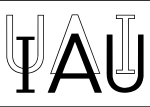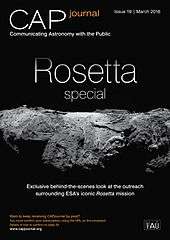International Astronomical Union
| Union astronomique internationale | |
 | |
|
National members from 74 countries | |
| Formation | 28 July 1919 |
|---|---|
| Headquarters | Paris, France |
Membership |
12,450 individual members[1] 74 national members |
President | Silvia Torres-Peimbert |
General Secretary | Piero Benvenuti |
| Website |
www |
The International Astronomical Union (IAU; French: Union astronomique internationale, UAI) is an international association of professional astronomers, at the PhD level and beyond, active in professional research and education in astronomy.[2] Among other activities, it acts as the internationally recognized authority for assigning designations to celestial bodies (stars, planets, asteroids, etc.) and any surface features on them.[3]
The IAU is a member of the International Council for Science (ICSU). Its main objective is to promote and safeguard the science of astronomy in all its aspects through international cooperation. The IAU maintains friendly relations with organizations that include amateur astronomers in their membership. The IAU has its head office on the second floor of the Institut d'Astrophysique de Paris in the 14th arrondissement of Paris.[4] Working groups include the Working Group for Planetary System Nomenclature (WGPSN), which maintains the astronomical naming conventions and planetary nomenclature for planetary bodies, and the Working Group on Star Names (WGSN), which catalogs and standardizes proper names for stars. The IAU is also responsible for the system of astronomical telegrams which are produced and distributed on its behalf by the Central Bureau for Astronomical Telegrams. The Minor Planet Center also operates under the IAU, and is a "clearinghouse" for all non-planetary or non-moon bodies in the Solar System.[5] The Working Group for Meteor Shower Nomenclature and the Meteor Data Center coordinate the nomenclature of meteor showers.
History
The IAU was founded on July 28, 1919, at the Constitutive Assembly of the International Research Council (now International Council for Science) held in Brussels, Belgium.[6][7] Two subsidiaries of the IAU were also created at this assembly: the International Time Commission seated at the International Time Bureau in Paris, France, and the International Central Bureau of Astronomical Telegrams initially seated in Copenhagen, Denmark.[6] The 7 initial member states were Belgium, Canada, France, Great Britain, Greece, Japan, and the United States, soon to be followed by Italy and Mexico.[6] The first executive committee consisted of Benjamin Baillaud (President, France), Alfred Fowler (General Secretary, UK), and four vice presidents: William Campbell (USA), Frank Dyson (UK), Georges Lecointe (Belgium), and Annibale Riccò (Italy).[6] Thirty-two Commissions (referred to initially as Standing Committees) were appointed at the Brussels meeting and focused on topics ranging from relativity to minor planets. The reports of these 32 Commissions formed the main substance of the first General Assembly, which took place in Rome, Italy, May 2–10, 1922. By the end of the first General Assembly, ten additional nations (Australia, Brazil, Czecho-Slovakia, Denmark, the Netherlands, Norway, Poland, Romania, South Africa, and Spain) had joined the Union, bringing the total membership to 19 countries. Although the Union was officially formed eight months after the end of World War I, international collaboration in astronomy had been strong in the pre-war era (e.g., the Astronomische Gesellschaft Katalog projects since 1868, the Astrographic Catalogue since 1887, and the International Union for Solar research since 1904).[6]
The first 50 years of the Union's history are well documented.[6][7] Subsequent history is recorded in the form of reminiscences of past IAU Presidents and General Secretaries. Twelve of the fourteen past General Secretaries in the period 1964-2006 contributed their recollections of the Union's history in IAU Information Bulletin No. 100.[8] Six past IAU Presidents in the period 1976–2003 also contributed their recollections in IAU Information Bulletin No. 104.[9]
Composition
The IAU counts a total of 12,376 members, professional astronomers from 96 countries worldwide.[10] 83% of all individual members are male, while 17% are female, among them the union's current president, astronomer Silvia Torres-Peimbert.
Membership also includes 74 national members, professional astronomical communities representing their country's affiliation with the IAU. National members include the Australian Academy of Science, the Chinese Astronomical Society, the French Academy of Sciences, the Indian National Science Academy, the National Academies (United States), the National Research Foundation of South Africa, the National Scientific and Technical Research Council (Argentina), KACST (Saudi Arabia), the Council of German Observatories, the Royal Astronomical Society (United Kingdom), the Royal Astronomical Society of New Zealand, the Royal Swedish Academy of Sciences, the Russian Academy of Sciences, and the Science Council of Japan, among many others.[11]
The sovereign body of the IAU is its General Assembly, which comprises all members. The Assembly determines IAU policy, approves the Statutes and By-Laws of the Union (and amendments proposed thereto) and elects various committees.
The right to vote on matters brought before the Assembly varies according to the type of business under discussion. The Statutes consider such business to be divided into two categories:
- issues of a "primarily scientific nature" (as determined by the Executive Committee), upon which voting is restricted to individual members, and
- all other matters (such as Statute revision and procedural questions), upon which voting is restricted to the representatives of national members.
On budget matters (which fall into the second category), votes are weighted according to the relative subscription levels of the national members. A second category vote requires a turnout of at least two-thirds of national members in order to be valid. An absolute majority is sufficient for approval in any vote, except for Statute revision which requires a two-thirds majority. An equality of votes is resolved by the vote of the President of the Union.

General Assemblies
Since 1922, the IAU General Assembly meets every three years, with the exception of the period between 1938 and 1948, due to World War II. After a Polish request in 1967, and by a controversial decision of the then President of the IAU, an Extraordinary IAU General Assembly was held in February 1973 in Warsaw, Poland, to commemorate the 500th anniversary of the birth of Nicolaus Copernicus, soon after the regular 1973 GA had been held in Australia.
| Meeting | Year | Venue |
|---|---|---|
| Ist IAU General Assembly (1st) | 1922 | Rome, Italy |
| IInd IAU General Assembly (2nd) | 1925 | Cambridge, England, United Kingdom |
| IIIrd IAU General Assembly (3rd) | 1928 | Leiden, Netherlands |
| IVth IAU General Assembly (4th) | 1932 | Cambridge, Massachusetts, United States |
| Vth IAU General Assembly (5th) | 1935 | Paris, France |
| VIth IAU General Assembly (6th) | 1938 | Stockholm, Sweden |
| VIIth IAU General Assembly (7th) | 1948 | Zürich, Switzerland |
| VIIIth IAU General Assembly (8th) | 1952 | Rome, Italy |
| IXth IAU General Assembly (9th) | 1955 | Dublin, Ireland |
| Xth IAU General Assembly (10th) | 1958 | Moscow, Soviet Union |
| XIth IAU General Assembly (11th) | 1961 | Berkeley, California, United States |
| XIIth IAU General Assembly (12th) | 1964 | Hamburg, West Germany |
| XIIIth IAU General Assembly (13th) | 1967 | Prague, Czechoslovakia |
| XIVth IAU General Assembly (14th) | 1970 | Brighton, England, United Kingdom |
| XVth IAU General Assembly (15th) | 1973 | Sydney, New South Wales, Australia |
| XVIth IAU General Assembly (16th) | 1976 | Grenoble, France |
| XVIIth IAU General Assembly (17th) | 1979 | Montreal, Quebec, Canada |
| XVIIIth IAU General Assembly (18th) | 1982 | Patras, Greece |
| XIXth IAU General Assembly (19th) | 1985 | New Delhi, India |
| XXth IAU General Assembly (20th) | 1988 | Baltimore, Maryland, United States |
| XXIst IAU General Assembly (21st) | 1991 | Buenos Aires, Argentina |
| XXIInd IAU General Assembly (22nd) | 1994 | The Hague, Netherlands |
| XXIIIrd IAU General Assembly (23rd) | 1997 | Kyoto, Kansai, Japan |
| XXIVth IAU General Assembly (24th) | 2000 | Manchester, England, United Kingdom |
| XXVth IAU General Assembly (25th) | 2003 | Sydney, New South Wales, Australia |
| XXVIth IAU General Assembly (26th) | 2006 | Prague, Czech Republic |
| XXVIIth IAU General Assembly (27th) | 2009 | Rio de Janeiro, Brazil |
| XXVIIIth IAU General Assembly (28th) | 2012 | Beijing, China |
| XXIXth IAU General Assembly (29th) | 2015 | Honolulu, Hawaii, United States |
| XXXth IAU General Assembly (30th) | 2018 | Vienna, Austria |
| XXXIst IAU General Assembly (31st) | 2021 | Busan, Republic of Korea |
The Commission 46: Education in astronomy
Commission 46 is a Committee of the Executive Committee of the IAU, playing a special role in the discussion of astronomy development with governments and scientific academies. The IAU is affiliated with the International Council of Scientific Unions (ICSU), a non-governmental organization representing a global membership that includes both national scientific bodies and international scientific unions. They often encourage countries to become members of the IAU. The Commission further seeks to development, information or improvement of astronomical education. Part of Commission 46, is Teaching Astronomy for Development (TAD) program in countries where there is currently very little astronomical education. Another program is named the Galileo Teacher Training Program (GTTP), being a project of the International Year of Astronomy 2009, among which Hands-On Universe that will concentrate more resources on education activities for children and schools designed to advance sustainable global development. GTTP is also concerned with the effective use and transfer of astronomy education tools and resources into classroom science curricula. A strategic plan for the period 2010-2020 has been published.[12]
Publications

In 2004 the IAU contracted with the Cambridge University Press to publish the Proceedings of the International Astronomical Union.[14]
In 2007, the Communicating Astronomy with the Public Journal Working Group prepared a study assessing the feasibility of the Communicating Astronomy with the Public Journal (CAPjournal).
See also
References
- ↑ Fienberg, Rick (14 August 2015). "A New Tally of Individual IAU Members" (PDF). Kai'aleleiaka. p. 3. Retrieved 11 October 2016.
- ↑ "About the IAU". International Astronomical Union. Retrieved 11 October 2016.
- ↑ Overbye, Dennis (4 August 2014). "You Won't Meet the Beatles in Space - Plan to Liven Official Naming of Stars and Planets Hits Clunky Notes". New York Times. Retrieved 11 October 2016.
- ↑ "IAU Secretariat." International Astronomical Union. Retrieved on 26 May 2011. "Address: IAU - UAI Secretariat 98-bis Blvd Arago F–75014 PARIS FRANCE" and "The IAU Secretariat is located in the Institut d'Astrophysique de Paris, 2nd floor, offices n°270, 271 and 283."
- ↑ "Centres – Minor Planet Center". International Astronomical Union. Retrieved 20 April 2016.
- 1 2 3 4 5 6 Blaauw, Adriaan (1994). History of the IAU : the birth and first half-century of the International Astronomical Union. Dordrecht: Kluwer Academic Publishers. ISBN 0-7923-2979-1.
- 1 2 Adams, Walter S. (February 1949). "The History of the International Astronomical Union" (PDF). Publications of the Astronomical Society of the Pacific. 61 (358): 5. Bibcode:1949PASP...61....5A. doi:10.1086/126108. Retrieved 20 April 2016.
- ↑ IAU Information Bulletin No. 100, July 2007
- ↑ IAU Information Bulletin No. 104, June 2009
- ↑ As of August 2015, iau.org
- 1 2 "National Members". International Astronomical Union. Retrieved 11 October 2016.
- ↑ Astronomy for the Developing World, Building from the IYA 2009, Strategic Plan 2010-20
- ↑ "CAPjournal Rosetta Special Out Now". Retrieved 28 March 2016.
- ↑ "Proceedings of the International Astronomical Union". Cambridge Journals Online. Cambridge University Press. Retrieved 1 September 2015.
- Statutes of the IAU, VII General Assembly (1948), pp. 13–15
External links
| Wikimedia Commons has media related to International Astronomical Union. |
- Official website
- XXVIth General Assembly 2006
- XXVIIth General Assembly 2009
- XXVIIIth General Assembly 2012
- XXIXth General Assembly 2015
- XXXIst General Assembly 2021